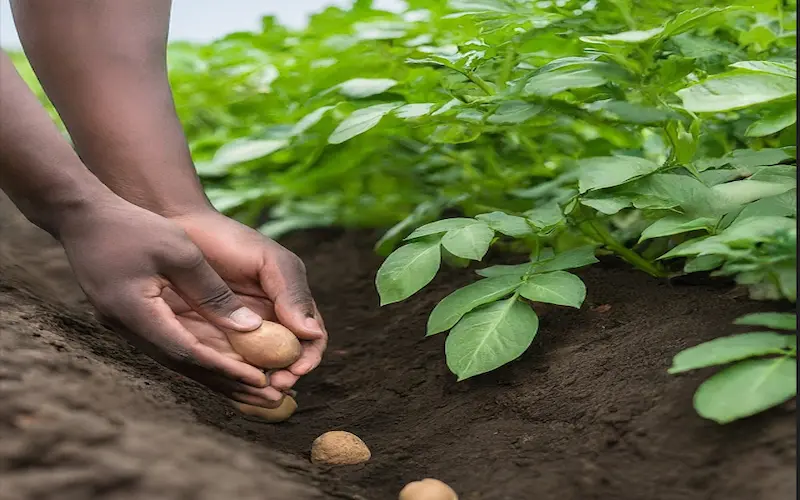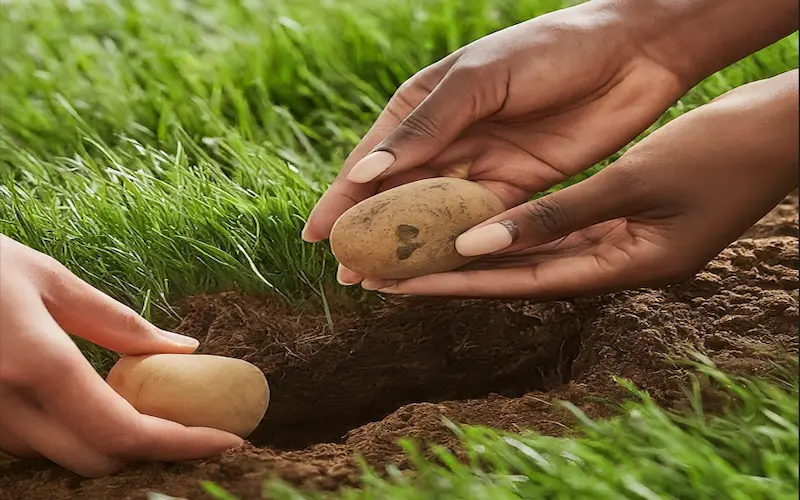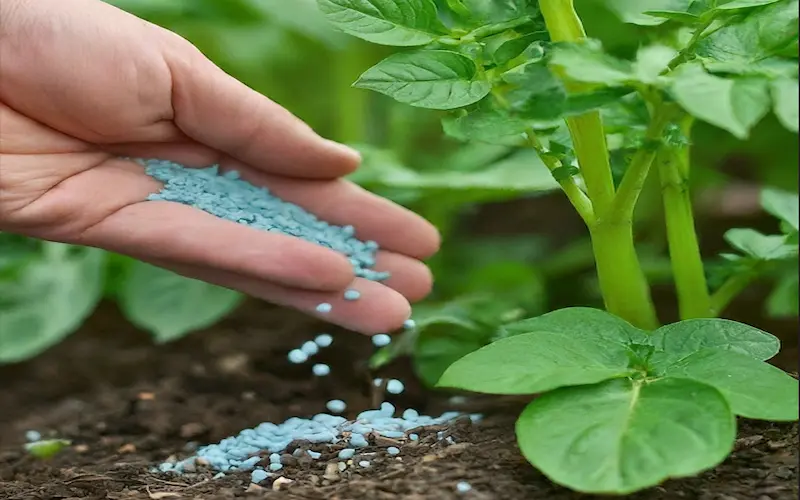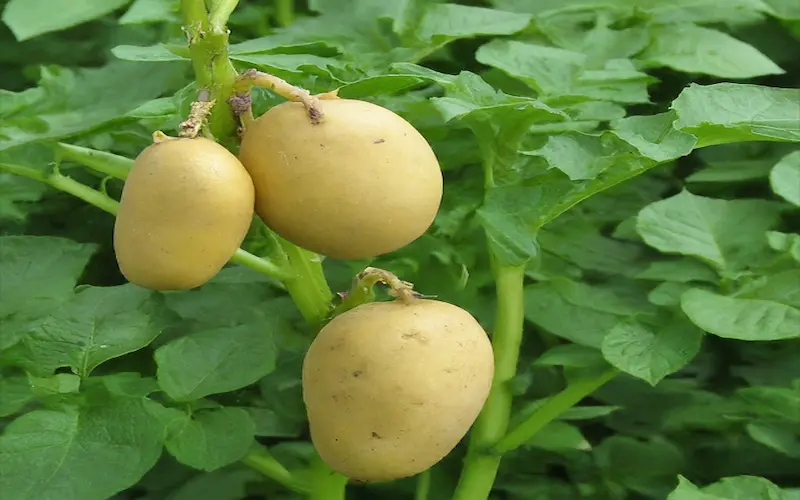Potato Farming
Published: 4 Dec 2023
In this article, we will give you our guide to potato farming. This article will take you through all the steps, techniques, and things to consider for potato cultivation. Whether you’re a rancher or a novice wandering into farming, this guide will furnish you with the information required for a potato collect. Prepare to investigate the universe of potato cultivating, where each stage assumes a part in carrying delectable potatoes from the dirt to your table. Furthermore, we will brief you about how to grow a potato plant.

Planning and Preparation:
Potato farming success begins with meticulous planning and thorough preparation. To achieve optimal results, follow these key steps:
Land Preparation: Before planting, ensure your soil is well-prepared. Perform soil tests to determine its composition and pH level. Potatoes thrive in well-drained, loose soil with a slightly acidic to neutral ph. Remove any debris, rocks, or weeds from the planting area. Adequate land preparation sets the foundation for a healthy and productive potato crop.
Suitable Soil Types: Understanding the soil type suitable for potato cultivation is crucial. Sandy loam or loamy soils are ideal, providing good drainage and aeration for the growing tubers. Avoid heavy clay soils that can lead to waterlogged conditions, potentially causing rot and disease.
Planting and Harvesting Time: Timing is critical in potato farming. For planting it is generally advised to select the season preferably during spring when the soil has reached a warmer temperature. Keep in mind that harvesting times can differ depending on the region so it is important to consider the conditions, in your area. Knowing the optimal time for these crucial stages ensures a successful potato crop.
Irrigation Requirements: Potatoes require consistent moisture, especially during the tuber development stage. Implement an efficient irrigation system based on your local climate conditions. Adequate watering not only promotes healthy growth but also helps prevent common issues like cracking and irregular tuber shapes.
Crop Rotation: To maintain soil health and minimize the risk of pests and diseases, practice crop rotation. Avoid planting potatoes in the same area consecutively. Rotate with crops from different families to disrupt pest cycles and improve overall soil fertility.
Pest Management: Identify common pests that affect potato crops in your region. Implement effective pest management strategies, which may include natural predators, organic pesticides, or preventive measures. Regular monitoring and timely intervention contribute to a pest-free and thriving potato crop.
Manure Application: Prioritize soil nutrition by applying suitable manure. Well-rotted organic manure or compost provides essential nutrients for potato plants. Ensure a balanced nutrient profile to support healthy growth and high yields.
By carefully addressing these planning and preparation aspects, you set the stage for a successful potato farming venture. Taking the time to understand your soil, climate, and crop needs pays off with a rewarding harvest.
Planting Process:
After you have finished planning and preparing it is time to start planting your potato crop. Implement these steps to ensure a beginning.

Seed Selection: Choose high-quality seed potatoes for planting. Select disease-free, certified seeds from reputable sources. The choice of seed varieties depends on factors such as your local climate, soil conditions, and intended use of the potatoes (e.g., table consumption or processing).
Fertilization: Prior to planting, apply a balanced fertilizer to the soil. Potatoes require adequate nutrients, especially phosphorus and potassium, for optimal growth. Incorporate the fertilizer evenly into the soil to provide a nutrient-rich environment for the developing plants.

Planting Techniques: Potatoes can be planted using various techniques, including trench planting and hilling. Trench planting involves digging trenches and placing seed potatoes at the bottom before covering them with soil. Hilling, on the other hand, involves mounding soil around the growing plants as they emerge. Both methods provide essential hilling for proper tuber development.
Spacing and Depth: Proper spacing is crucial to allow for adequate sunlight, airflow, and room for tuber expansion. Place seed potatoes at the recommended spacing and depth, usually around 12-15 inches apart and 3-4 inches deep. This ensures each plant has sufficient space to grow and produce healthy tubers.
Watering: Immediately after planting, ensure thorough watering to set the seeds and initiate germination. Maintain consistent soil moisture throughout the growing season, adjusting irrigation based on weather conditions. Adequate water is crucial during the flowering and tuber formation stages. Watering will help to grow a potato.
Weed Control: Keep the potato field free from weeds, which compete for nutrients and water. Regularly check for weed growth and implement effective weed control measures, such as hand weeding or mulching. Preventing weed competition contributes to higher yields and healthier plants.
Irrigation Practices: Potatoes require consistent moisture, but overwatering can lead to issues like rot. Implement a controlled irrigation schedule, ensuring the soil remains consistently moist but not waterlogged. Drip irrigation or soaker hoses are efficient methods to deliver water directly to the roots.
By following these planting guidelines, you set the foundation for a robust potato crop. Attention to detail during this critical phase contributes significantly to the overall success of your potato farming venture.
Crop Maintenance: Maintaining a healthy potato crop involves ongoing care and attention to ensure optimal growth and minimize potential issues. Here are key practices to implement during the growing season:
Monitoring Plant Health: Routinely assess your potato plants for indications of vermin, infections, or supplement inadequacies. Early identification takes into consideration brief intercession, forestalling the heightening of issues that could influence the general yield wellbeing.
Fertilizer Application: Continue providing nutrients to the potato plants throughout their growth stages. Consider side-dressing with additional fertilizer during the early stages of tuber formation to support robust tuber development. Adjust fertilizer application based on soil test results and plant needs.
Hilling: Hilling or mounding soil around the base of the growing potato plants is a crucial practice. This helps prevent tubers from being exposed to sunlight, which can cause them to turn green and become toxic. Hilling also provides support to the plants and promotes increased tuber formation.

Pest Management:
Implement a proactive pest management strategy to protect your potato crop. Identify common pests in your region and employ suitable control methods. This may include using natural predators, applying organic pesticides, or implementing cultural practices that deter pests.
Disease Prevention: Potatoes are susceptible to various diseases, including late blight and early blight. Practice crop rotation, choose disease-resistant varieties, and apply appropriate fungicides preventively. Timely action is crucial to curbing the spread of diseases and preserving the overall crop yield.
Supporting Plant Structure: As the potato plants grow, they might need extra help to forestall bowing or breaking, particularly during breezy circumstances. Stake or provide support structures to ensure the plants remain upright, promoting optimal exposure to sunlight and air circulation.
Water Management: Maintain consistent soil moisture levels, especially during critical growth stages such as flowering and tuber development. Be cautious not to overwater, as this can lead to issues like tuber rot. Adjust irrigation practices based on weather conditions and the specific needs of your potato plants.
Mulching:
Applying a layer of mulch around the potato plants assists save with ruining dampness, stifle weed development, and control soiltemperature. Choose organic mulch materials that break down over time, enriching the soil as they decompose.
By diligently attending to these crop maintenance practices, you contribute to the overall health and productivity of your potato crop. Regular monitoring, timely interventions, and proactive measures ensure a successful growing season and a bountiful harvest.
Harvesting and Storage:
Harvesting marks the culmination of your potato farming efforts, and proper storage ensures the longevity and quality of your yield. Follow these steps for a successful harvest and post-harvest handling:
Harvest Timing: Potatoes are typically ready for harvest when the tops of the plants have died back, signaling the end of the growing season. Use a fork or shovel to carefully unearth the tubers. Avoid harvesting during wet conditions to prevent soil adherence and potential tuber damage.
Gentle Harvesting: Handle harvested potatoes with care to minimize bruising or damage. Use appropriate tools and avoid dropping or throwing the tubers. Damaged potatoes are more susceptible to rot during storage.
Curing: After harvesting, allow the potatoes to cure in a cool, dark place for about two weeks. Curing helps toughen the skin, heal minor injuries, and improve the overall storage quality. Maintain proper ventilation during this period.
Sorting and Grading: Inspect each potato for size, shape, and any signs of disease or damage. Sort the potatoes into different grades based on these criteria. Top caliber, intact tubers are appropriate for long haul stockpiling, while more modest or harmed ones can be utilized for sure fire utilization.
Capacity Conditions: Potatoes store best in cool, dim, and all around ventilated conditions. Aim for a storage temperature around 40°F (4°C) to inhibit sprouting and slow down the aging process. Keep them away from direct sunlight, which can cause greening.

Avoiding Sprouting:
To prevent sprouting, store potatoes away from ethylene-producing fruits, such as apples. Additionally, regular monitoring and removal of any sprouting potatoes help maintain the overall quality of the stored crop.
Ventilation: Ensure proper ventilation in your storage area to prevent the buildup of excess moisture. Good airflow helps reduce the risk of diseases and rot. Use storage bins or containers with ventilation holes, and avoid sealing potatoes in airtight bags.
Regular Inspection: Periodically inspect stored potatoes for any signs of decay, sprouting, or disease. Promptly remove any damaged or spoiled tubers to prevent the spread of issues to the entire stored crop.
Long-Term Storage Options: For extended storage, consider options like root cellars, cool basements, or specialized potato storage facilities. These environments provide the necessary cool temperatures and ventilation for preserving potatoes over an extended period.
By following these guidelines for harvesting and storage, you maximize the longevity and quality of your potato harvest. Proper handling during these crucial stages ensures that your hard work in the field translates into a lasting and valuable yield.
Global Perspective: Understanding the global context of potato farming provides valuable insights into industry trends, challenges, and innovations. Explore the broader aspects of potato cultivation around the world:
Global Potato Production:
Potatoes are a staple harvest around the world, contributing essentially to worldwide food security. Acquire experiences into significant potato-creating areas, including Europe, Asia, North America, and Africa. Understanding the geographical distribution of potato cultivation provides a broader perspective on the crop’s significance.
Climate Variations and Adaptations:
Explore how different climate zones influence potato cultivation practices. From the cool climates of northern Europe to the warmer regions in Asia, farmers adapt their techniques to suit the prevailing weather conditions. Insights into these adaptations can inform local practices and help navigate climate challenges.
Technological Innovations:
Stay updated on the latest technological advancements in potato farming globally. Precision agriculture, smart farming practices, and innovative machinery play crucial roles in enhancing efficiency and productivity. Learn about cutting-edge technologies shaping the future of potato cultivation.
Trade and Economic Impact:
Potatoes are not only a vital food source but also a key commodity in global trade. Understand the economic impact of potato farming, including export and import trends, market dynamics, and the role of potatoes in various national economies.
Challenges and Solutions: Examine common challenges faced by potato farmers worldwide, such as pest management, climate change, and market fluctuations. Explore innovative solutions and best practices implemented in different regions to address these challenges sustainably.
Collaborative Initiatives: Discover collaborative efforts and initiatives aimed at improving global potato production. International organizations, research institutions, and agricultural networks often work together to share knowledge, promote sustainable practices, and address common issues faced by potato farmers.
Cultural Significance: Potatoes hold cultural significance in various cuisines globally. Explore how different cultures incorporate potatoes into their traditional dishes and the role of this versatile crop in culinary heritage.
Environmental Impact: Gain insights into the environmental impact of potato farming practices on a global scale. Explore sustainable farming methods, agro ecological approaches, and initiatives promoting environmentally friendly potato cultivation.
Market Trends and Consumer Preferences: Stay informed about evolving market trends and consumer preferences related to potatoes. From the rise of specialty potato varieties to the demand for organic produce, understanding market dynamics is crucial for farmers and stakeholders in the potato industry.
By exploring the global perspective of potato farming, you not only gain a broader understanding of the crop’s significance but also access valuable knowledge that can inform and inspire local practices. Stay connected to the global potato community to foster innovation, sustainability, and shared success in potato cultivation.
Varieties and Yield:
Variety selection plays a pivotal role in the success of potato farming, influencing yield, disease resistance, and adaptability. Delve into the diverse world of potato varieties and their impact on crop productivity:
Popular Varieties With Their Yield: Explore well-known potato varieties and their specific characteristics. Varieties like Russet, Yukon Gold, and Kennebec are celebrated for their taste, texture, and versatility. Understand the yield potential of each variety, considering factors such as climate, soil conditions, and intended use.
Successful Varieties: Highlight successful potato varieties that have proven resilient and high-yielding in various regions. These varieties often exhibit resistance to common diseases and pests, making them reliable choices for farmers seeking consistent and abundant harvests.
The Correct Variety Properties: Each potato variety possesses distinct properties, from skin color to flesh texture. Understanding these characteristics is crucial for meeting market demands and consumer preferences. Some varieties excel in baking, while others are prized for their suitability for mashed or fried potatoes.
Adapting to Local Conditions: Consider the adaptability of potato varieties to local soil and climate conditions. Certain varieties thrive in colder climates, while others are well-suited to warmer regions. Choosing varieties that align with your specific growing conditions enhances the likelihood of a successful harvest.
Climate-Resilient Varieties: Explore potato varieties bred for resilience in the face of climate change. Climate-resilient varieties often exhibit tolerance to extreme temperatures, drought, or other environmental stressors. Incorporating these varieties into your farming practices contributes to long-term sustainability.
Market Demand and Specialty Varieties: Evaluate market trends and consumer preferences to select potato varieties in line with current demands. Specialty varieties, such as colorful or heirloom potatoes, may cater to niche markets seeking unique culinary experiences. Stay attuned to market dynamics to align your choices with consumer preferences.
Disease-Resistant Varieties: Mitigate the risk of diseases affecting potato crops by opting for disease-resistant varieties. Varieties engineered or naturally resistant to common issues like late blight or scab provide a proactive approach to crop health and overall yield.
High-Yield Cultivars: Identify high-yield potato cultivars recognized for their productivity. These varieties often demonstrate efficient use of resources and robust tuber development. Information on the yield potential of different cultivars assists farmers in maximizing production.
Local Success Stories: Highlight success stories of local farmers who have achieved notable results by selecting specific potato varieties. Learn from their experiences and insights, considering how their choices align with local conditions and market dynamics.
By navigating the diverse landscape of potato varieties, farmers can tailor their selections to meet specific goals and challenges. Whether aiming for high yields, disease resistance, or market appeal, the right choice of potato varieties forms a cornerstone for successful and sustainable potato farming.
Post-Harvest Considerations:
The post-harvest phase is critical in preserving the quality and market value of your potato crop. Paying attention to careful handling and storage practices ensures the fruits of your labor reach consumers in optimal condition. Here’s a detailed look at essential post-harvest considerations:
Sorting and Grading: Immediately after harvesting, sort and grade potatoes based on size, shape, and quality. Remove any damaged or undersized tubers. This process not only enhances the market value of your crop but also facilitates efficient storage and distribution.
Curing for Storage: Curing is a crucial step to toughen the skin and improve the shelf life of potatoes. Place the harvested potatoes in a well-ventilated, dark area with temperatures around 50-60°F (10-15°C) for approximately two weeks. This allows minor injuries to heal and prepares the tubers for long-term storage.
Storage Conditions: Choose the right storage conditions to prevent sprouting, rot, and other storage-related issues. Keep a cool, dull capacity region with reliable temperatures around 40°F (4°C). Sufficient ventilation is fundamental to forestall the development of overabundance dampness and decrease the gamble of infections.
Sprout Control: Prevent sprouting during storage by using sprout inhibitors or storing potatoes away from ethylene-producing fruits. Regularly inspect stored potatoes and remove any sprouting tubers promptly to maintain the overall quality of the stored crop.
Regular Inspection and Maintenance: Periodically inspect stored potatoes for signs of decay, rot, or any other issues. Promptly remove any damaged or spoiled tubers to prevent the spread of problems to the entire stored crop. Regular maintenance ensures a healthier and longer-lasting potato supply.
Packaging for Market: When preparing potatoes for market, consider appropriate packaging to protect them during transportation and display. Packaging should allow for ventilation to prevent moisture buildup and maintain the quality of the potatoes. Clear labeling provides consumers with essential information about the product.
Market Distribution Strategies: Plan effective distribution strategies to ensure your potatoes reach consumers while they are still fresh. Collaborate with local markets, grocery stores, or on the other hand even think about direct-to-customer deals through rancher’s business sectors or local area upheld agribusiness (CSA) programs.
Value-Added Processing: Explore value-added processing options to diversify your potato offerings. This could include producing potato chips, pre-cut fries, or dehydrated potato products. Value-added processing not only expands market opportunities but also reduces post-harvest waste.
Quality Control Measures: Implement quality control measures throughout the post-harvest process. Regularly check stored potatoes for signs of spoilage, monitor packaging integrity, and ensure that distribution channels maintain the necessary conditions for preserving potato quality.
Sustainable Practices: Consider sustainable post-harvest practices to minimize environmental impact. From eco-friendly packaging options to efficient transportation methods, incorporating sustainability into your post-harvest operations aligns with modern consumer expectations.
By concentrating entirely on these post-gather contemplations, you safeguard the nature of your potatoes as well as add to the general achievement and supportability of your potato cultivating adventure. Efficient post-harvest practices enhance the market value of your produce and foster long-term success in the agricultural industry.
Emerging Trends in Potato Farming:
Staying abreast of emerging trends in potato farming is essential for farmers looking to optimize production, sustainability, and market relevance. Explore the evolving landscape of potato cultivation and consider integrating these trends into your farming practices:
Precision Agriculture: Embrace precision agriculture techniques to enhance efficiency and resource management. Technologies like GPS-guided tractors, drones, and soil sensors enable precise planting, fertilization, and irrigation, leading to improved yields and reduced environmental impact.
Smart Farming Practices: Incorporate brilliant cultivating rehearses that influence information investigation, AI, and the Web of Things (IoT). These innovations empower ongoing observing of yield conditions, assisting ranchers with settling on informed choices in regards to water system, bug control, and by and large harvest wellbeing.
Climate-Resilient Varieties: With changing climate patterns, the demand for climate-resilient potato varieties is on the rise. Researchers and breeders are developing varieties that can withstand temperature fluctuations, water scarcity, and other climate-related challenges, ensuring stable yields in varying environmental conditions.
Organic Potato Farming: Responding to growing consumer preferences for organic produce, many farmers are shifting towards organic potato farming. Avoiding synthetic pesticides and fertilizers, organic farming promotes soil health and produces potatoes free from chemical residues, appealing to health-conscious consumers.
Vertical Farming and Controlled Environment Agriculture (CEA): Explore vertical farming and CEA techniques to maximize space utilization and control growing conditions. These methods, often implemented in urban settings, enable year-round potato cultivation, reduce water usage, and provide a controlled environment to minimize pest and disease risks.
Block chain Technology in Supply Chain: Implement block chain technology in the potato supply chain to enhance transparency and traceability. Block chain ensures accurate record-keeping, from seed sourcing to the final consumer, fostering trust and accountability in the food production process.
Urban and Suburban Potato Farming: Urban and suburban potato farming is gaining popularity as more people seek locally sourced produce. Small-scale potato farming in urban settings, whether in backyard gardens, rooftop farms, or community plots, contributes to food security and promotes sustainable agriculture.
Biotechnology and Genetic Engineering: Explore advancements in biotechnology and genetic engineering for improved potato traits. Hereditarily changed (GM) potatoes might offer protection from bugs, sicknesses, and natural stressors, possibly prompting more significant returns and decreased dependence on substance inputs.
Circular Economy Practices: Adopt circular economy practices by incorporating waste reduction, recycling, and resource efficiency into potato farming operations. Use potato squander for treating the soil or as feedstock for bioenergy creation, adding to an additional reasonable and earth cognizant rural model.
Consumer-Focused Varieties: Tailor potato varieties to consumer preferences by offering unique colors, shapes, and flavors. Specialty and heirloom varieties cater to niche markets, while addressing evolving culinary trends and diverse consumer tastes.
By aligning with these emerging trends, potato farmers can position themselves for success in a dynamic agricultural landscape. Incorporating innovative practices not only enhances productivity but also contributes to the sustainability and resilience of potato farming operations.
Future Prospects and Innovations in Potato Farming:
As potato farming continues to evolve, the future holds exciting prospects and innovations that can revolutionize the industry. Explore the anticipated developments that may shape the future of potato cultivation:
Genomic Breeding Techniques: Genomic breeding techniques, including marker-assisted selection and gene editing, are expected to play a pivotal role in developing improved potato varieties. These techniques allow for more precise and accelerated breeding, resulting in varieties with enhanced traits such as resistance to diseases, improved nutritional content, and increased yield.
Climate-Smart Agriculture: The agricultural sector, including potato farming, is likely to witness increased adoption of climate-smart practices. Farmers will explore strategies to mitigate the impact of climate change, incorporating resilient varieties, precision irrigation, and sustainable soil management to adapt to changing environmental conditions.
Robotics and Automation: The integration of robotics and automation in potato farming is poised to increase efficiency and reduce labor-intensive tasks. From automated planting and harvesting systems to robotic weeding and monitoring, these technologies aim to streamline operations, minimize resource use, and optimize overall crop management.
Digital Agriculture Platforms: Digital agriculture platforms leveraging data analytics, artificial intelligence, and machine learning are expected to become more sophisticated. These stages will furnish ranchers with noteworthy experiences, assisting them with settling on informed choices in regards to trim administration, asset allotment, and irritation control.
Vertical Farming Advancements: Advancements in vertical farming techniques, especially in controlled environment agriculture (CEA), will continue to offer innovative solutions for urban and indoor potato cultivation. Vertical farming can enhance space utilization, reduce water consumption, and enable year-round production in various urban settings.
Biological Pest Control: The future of potato farming may see a shift towards increased use of biological pest control methods. Beneficial insects, microbial agents, and natural predators can be employed to manage pests, reducing reliance on chemical pesticides and promoting environmentally friendly practices.
Block chain for Traceability: Block chain technology is anticipated to play a significant role in enhancing traceability and transparency in the potato supply chain. From seed sourcing to consumer purchase, block chain ensures an immutable record, fostering trust among consumers and stakeholders in the food production system.
Hydroponics and Aeroponics Integration: Hydroponics and aeroponics, soil-less cultivation methods, may see increased integration into potato farming systems. These methods offer precise nutrient delivery, reduced water usage, and potential resistance to soil-borne diseases, making them attractive for sustainable and high-yield potato production.
Circular Economy Principles: The adoption of circular economy principles is expected to gain momentum. Potato farming operations may increasingly focus on minimizing waste, reusing by-products, and optimizing resource use. Circular economy practices contribute to sustainability, resource efficiency, and resilience in the face of changing agricultural landscapes.
Worldwide Cooperation and Information Sharing: The eventual fate of potato cultivating includes expanded worldwide joint effort and information sharing. Farmers, researchers, and agricultural organizations from different regions will likely collaborate to address common challenges, share innovations, and collectively work towards sustainable and resilient potato production on a global scale.
As the potato farming landscape evolves, these future prospects and innovations hold the potential to shape a more sustainable, efficient, and resilient industry. Embracing these advancements will not only benefit individual farmers but contribute to the overall growth and viability of potato farming worldwide.
Conclusion
In conclusion, the dynamic world of potato farming, including when to plant potatoes and when to grow potatoes, is witnessing a transformative journey marked by innovation, sustainability, and adaptability. From the adoption of precision agriculture and smart farming practices to the exploration of climate-resilient varieties and cutting-edge technologies like block chain; the industry is evolving to meet the challenges of the future, including potatoes agriculture.
As we anticipate developments in genomic breeding, robotics, and digital agriculture, the potential for increased efficiency, reduced environmental impact, and enhanced global collaboration becomes evident, influencing when to plant and grow potatoes.
The future of potato farming holds promises for farmers willing to embrace emerging trends and innovations, paving the way for a resilient and thriving industry that addresses the needs of both producers and consumers.

- Be Respectful
- Stay Relevant
- Stay Positive
- True Feedback
- Encourage Discussion
- Avoid Spamming
- No Fake News
- Don't Copy-Paste
- No Personal Attacks



- Be Respectful
- Stay Relevant
- Stay Positive
- True Feedback
- Encourage Discussion
- Avoid Spamming
- No Fake News
- Don't Copy-Paste
- No Personal Attacks



